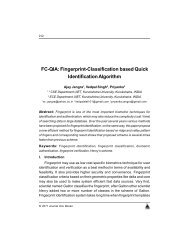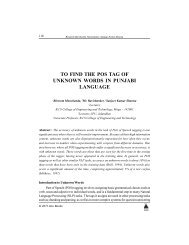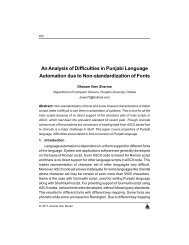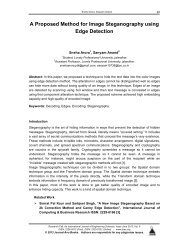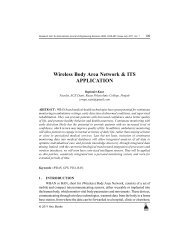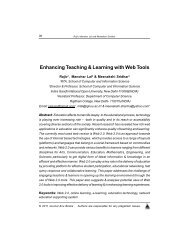Superior Security Data Encryption Algorithm - Ijoes.org
Superior Security Data Encryption Algorithm - Ijoes.org
Superior Security Data Encryption Algorithm - Ijoes.org
Create successful ePaper yourself
Turn your PDF publications into a flip-book with our unique Google optimized e-Paper software.
172Yashpal Mote, Paritosh Nehete, Shekhar Gaikwadperformance of thesealgorithms under different conditions, the presented comparisontakes into consideration the behavior and performance of the algorithm when differentdata loads are used. Simulation has been conducted in JAVA J2ME platform and onandroid O.S. At the end, this paper present a new algorithm for enhancing theperformance of available algorithm. The proposed method is faster on average thanthe best previously known method. This paper also present a highly efficientimplementation of NTRU within the android CryptographyArchitectureKeywords: <strong>Encryption</strong> <strong>Algorithm</strong>s, Cryptography, AES, DES, TripleDES,Blowfish& NTRU.1. IntroductionMobile phones are part of our daily life. Nowadays, Mobile phones provideus not only communication Services, but also many multimedia and otherFunctionsuseful for humanbeing. Mobile phones contain private orpersonal<strong>Data</strong>. This data is saved in a form of phone contacts,SMS, noticesin a calendar, photos etc. Protection of the information depends also on aconcrete user. TheUser should prevent against property of her/his withmobile phone.If the mobile phone is in wrong hands, most of the important informationis available without a great effort(Received SMS). User registers the theft ofthe mobile phone almost immediately, but tappingnot happens.The SMS tapping is possible in GSM network at some places. Therecould be used the encryption for securing of SMS. <strong>Encryption</strong> is most oftenrealized through some user encryption applications.Therefore, there is a need to provide an additional encryption on thetransmitted messages.<strong>Encryption</strong> can be classified into two categories Symmetric andAsymmetric. Symmetric encryption is the process where a single key isused for both encryption and decryption. It is somehow insecure to use.© 2012 Journal Anu Books Authors are responsible for any plagiarism issues.
Research Cell: An International Journal of Engineering Sciences ISSN: 2229-6913 Issue July 2012, Vol. 6173Asymmetric encryption uses two related keys, one for encryption and theother for decryption. One of the keys can be announced to the public as thepublickey and another kept secret as the private key. Themajor disadvantageof symmetric encryption is the key distribution that is mostly done through athird party. Key distribution through third party can negate the essence ofencryption if the key compromised by the third party.Hence, Papers study isbased on the use of asymmetricencryption technique in securing SMS. Thereare a lot of asymmetric encryption techniques but the commonly used inthe literature are Rivest, Shamir and Adleman (RSA),ELGamal3DES Advance<strong>Encryption</strong> standard (AES),Blowfish And NTRU. Due to this reason, in thisstudy of the thementioned algorithms have been done.This study introduces SMS, its security threats and the use ofasymmetric encryption technique in securing SMS.In section 2, the relatedworks is provided, followed by the algorithm description. Section 3 comparesthe underlying securityi.e. encrypt & decrypt speed of each algorithm fordifferent packet sizes. Their performance analysis in SMS encryption isalso given. Finally, Section 4 presents the conclusion of the paper.2. <strong>Data</strong> encryption <strong>Algorithm</strong>sDES: (<strong>Data</strong> <strong>Encryption</strong> Standard), was the first encryption standard to berecommended by NIST (National Institute of Standards and Technology). Itis based on the IBM proposed algorithm called Lucifer. DES became astandard in 1974. Since that time, many attacks and methods recorded thatexploit weaknesses of DES, which made it an insecure block cipher.3DES: As an enhancement of DES, the3DES (Triple DES) encryptionstandard was proposed. In this standard the encryption method is similar tothe one in original DES but applied 3 times to increase the encryption level.But it is a known fact that 3DES is slower than other block cipher methods.AES:(Advanced <strong>Encryption</strong> Standard), is the new encryption standardrecommended by NIST to replace DES. It was originally called© 2012 Journal Anu Books Authors are responsible for any plagiarism issues.
174Yashpal Mote, Paritosh Nehete, Shekhar GaikwadRijndael(pronounced Rain Doll). It was selected in 1997 after a competitionto select the best encryption standard. It has variable key lengthof 128, 192, or 256 bits; default 256. AES encryption is fast and flexible; itcan be implemented on various platforms especially in small devices Bruteforce attack isThe only effective attack known against it, in which the attacker tries totest all the characters combinations toun lock the encryption. Both AES andDES are block ciphers.Blowfish: It is one of the most common public domainencryption algorithmsprovided by Bruce Schneier – oneof the world’s leading cryptologists, andthe president of Counterpane Systems, a consulting firm specializing incryptography and computer security. It takes a variable length key, rangingfrom 32 bits to 448bits; default 128 bits. Blowfish is unpatented, license-free,and isavailable free for all uses.NTRU:The NTRU encryption scheme is an interesting alternative to wellestablished<strong>Encryption</strong> schemes such as ,RSA,DES, ElGamal, and ECIES. Thesecurity of NTRU depends on the hardness of computing short lattice vectorsand thus is a promising user for being quantum computer resistant. Therehas been extensive research onefficient implementation of the NTRUencryption scheme. In this paper, we presenta new algorithm forshowingthe performance of NTRU. The proposed method is faster on average thanthe best previously known procedures.3. Simulation ProcedureHere, our destination to measure the <strong>Encryption</strong> andDecryption speedfor each algorithm for different packet sizes. <strong>Encryption</strong> time is used tocalculate the throughput of an encryption pattern. It indicates the speed ofencryption. The throughput of the encryption scheme iscalculated by dividingthe total plaintext in Megabytes encrypted on the total encryption time for© 2012 Journal Anu Books Authors are responsible for any plagiarism issues.
Research Cell: An International Journal of Engineering Sciences ISSN: 2229-6913 Issue July 2012, Vol. 6175each algorithm in. As the throughput value is increased, the powerconsumption of this encryption technique is decreased. By consideringdifferent sizes of data blocks (0.5MBto 20MB) the algorithms were evaluatedresults in terms of the time taken to encrypt and decrypt the data block. Allthe implementations were exact to make sure that the results will be relativelyclean, fair and accurate.Figure 1- GUI of the simulation programThe Simulation program (shown in Fig. 1) Accepts Three inputs:<strong>Algorithm</strong>, Cipher Mode and data block size. After a successful execution,the data generated by it and encrypted and decrypted are shown in figure.Another comparison is made after the successful encryption/decryptionprocess to make sure that all the data are evaluated in the right way bycomparing the generated data (the originaldata blocks) and the decrypteddata block generated from the process.© 2012 Journal Anu Books Authors are responsible for any plagiarism issues.
176Yashpal Mote, Paritosh Nehete, Shekhar GaikwadTable 1 : Comparative Execution Times (in Milliseconds) of <strong>Encryption</strong><strong>Algorithm</strong>s with Different Packet Size.3.1 Simulation ResultsSimulation results for this compassion point are shown Fig. 2 and Table1 at encryption stage. The results show the superiority of NTRU algorithmover other algorithms in terms of the processing time. It can also beobservable here that 3DES and other algorithms has low performance interms of power consumption and throughput when compared with DESalgorithm. It requires always more time than DES because of its triple phaseencryption characteristicsof it.© 2012 Journal Anu Books Authors are responsible for any plagiarism issues.
Research Cell: An International Journal of Engineering Sciences ISSN: 2229-6913 Issue July 2012, Vol. 6177Fig. 2: Throughput of each encryption algorithmThis section will show the results obtained from running the simulationprogram using different data loads. The results show the impact of changingdata load on each algorithm and the impact of Cipher Mode (<strong>Encryption</strong>Mode) used.Simulation results for this compassion point are shown Fig. 3 and Table2 decryption stage. We can find in decryption that Blowfish is the better thanother algorithms and also NTRU is better than Blowfish algorithm i.e. betterthan all other algorithm in throughput and power consumption. So Finally,wecame to know that Triple DES (3DES) still requires more time than DESalgorithm.© 2012 Journal Anu Books Authors are responsible for any plagiarism issues.
178Yashpal Mote, Paritosh Nehete, Shekhar GaikwadFig. 3: Throughput of Each Decryption <strong>Algorithm</strong>(Megabyte/Sec)3.2 Performance Results with ECBThe first set of experiments conduct observed using ECB mode, resultsare shown below in Figure 4.Fig. 4: Performance Results with ECB ModeThe results show the superiority of NTRU<strong>Algorithm</strong> over all otheralgorithms in terms of processing time. It shows also that AESalgorithmconsumes more resources when data block size is relatively big. Another© 2012 Journal Anu Books Authors are responsible for any plagiarism issues.
Research Cell: An International Journal of Engineering Sciences ISSN: 2229-6913 Issue July 2012, Vol. 6179point can be noticed here that 3DES algorithm requires always more timethanDES algorithm because of its triple phase encryption characteristic.NTRU, which has a long key, outperformed other encryption algorithms.DES and 3DES algorithm are known to have worm holes in their securitymechanism, BlowfishAnd AES algorithms do not have any so far.Table 2Comparative Execution Times (in Milliseconds) of Decryption <strong>Algorithm</strong>swith Different Packet Size3.3 Performance Results with CBCAs expected, CBC requires more processing time than ECB becauseof its key-chaining nature of it . The results show in Fig. 5 indicates also thatthe extra time added is not much significant for many applications, knowingthat CBC is much better than ECB in terms of the protection of the data.© 2012 Journal Anu Books Authors are responsible for any plagiarism issues.
180Yashpal Mote, Paritosh Nehete, Shekhar GaikwadFig. 5: Performance Results with CBC ModeThe difference between these two modes is hard to see by the nakedeye, the results showed that the average difference between ECB and CBCis 0.059896 second, which is relatively very small.4. ConclusionThe simulation results shows that NTRU algorithm has betterperformance than other commonly used encryption algorithms. Since NTRUhas not any known security weak points so far, it can be considered as anexcellent standard encryption algorithm. AES showed poor performanceresults compared to other algorithms, since it requires more processingpower.References1. AamerNadeem, “A Performance Comparison of <strong>Data</strong> <strong>Encryption</strong> Algo”.IEEE 2005.2. Ferguson, N., Schneier, B., and Kohno T., (2010). “CryptographyEngineering: Design Principles and Practical Applications”. New York: John Wiley and Sons.© 2012 Journal Anu Books Authors are responsible for any plagiarism issues.
Research Cell: An International Journal of Engineering Sciences ISSN: 2229-6913 Issue July 2012, Vol. 61813. F.I.P. Standard, Advanced <strong>Encryption</strong> Standard (AES), National Instituteof Standards and Technology (NIST), 2001.4. Bruce Schneier. “The Blowfish <strong>Encryption</strong> <strong>Algorithm</strong> Retrieved”,October 25, 2008.5. A.A. Tamimi, “‘Performance Analysis of <strong>Data</strong> <strong>Encryption</strong><strong>Algorithm</strong>s”.Retrieved October 1, 2008.6. W. Stallings, “Cryptography and Network <strong>Security</strong>”7. Comparison of data encryption algorithms-SimarPreet Singh, andRaman Maini8. www.ntru.com9. JoffreyHoffstein , Jill Pipher , Joseph H Silverman “ NTRU – A ringbased public key cryptosystem”.10. JoffreyHoffstein , Joseph H Silverman “Optimizations for NTRU”* * * * *© 2012 Journal Anu Books Authors are responsible for any plagiarism issues.





